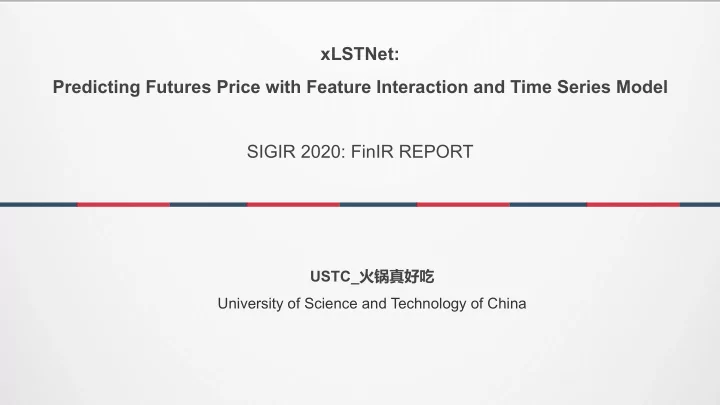

xLSTNet: Predicting Futures Price with Feature Interaction and Time Series Model SIGIR 2020: FinIR REPORT USTC_ ����� University of Science and Technology of China
1. Task 2. Methods Contents 3. Experiments 4. Results & Conclusion
Task: Predict the change of metal prices ü 3 sub-tasks ü Evaluation metric: accuracy ü Predict the rise and fall of 6 metals over 1-day, 20-day and 60-day period
Our Method: Data Collection ü Collect Dow Jones Industrial Index dataset ü Collect English and Chinese news text data ü Only use DOW dataset
Our Method: Data Preprocessing ü Only use LME dataset after 2005 ü Validation set: the last 10% of the above data ü Missing value preprocessing: replace it with the previous day's value ü Min-Max Normalization: scale the data into the range [-1, 1], where the maximum and minimum values are taken from the training set
Our Method: xLSTNet ü Idea: incorporate feature interactions[1] into LSTNet[2] ü Use the feature interaction inspired by the xDeepFM[1] ü Use the LSTNet model[2], a deep Learning Network specially designed for time series prediction [1] Lian, Jianxun , et al. "xDeepFM: Combining Explicit and Implicit Feature Interactions for Recommender Systems." (2018). [2] Lai, Guokun , et al. "Modeling Long- and Short-Term Temporal Patterns with Deep Neural Networks." The 41st International ACM SIGIR Conference ACM, 2018.
Main idea: LSTNet ü Use LSTNet to predict the Close Price , then to compute the label ü Loss function: use Minimum Mean Square Error instead of Absolute Error
Main idea: Feature Interactions Simplify the Compressed Interaction Network module in [1] to interact features
Experiments: Settings Baseline 1.Guess all 0 2.Lightgbm 3.LSTNet-Label 4.LSTNet-Close
Experiments: Settings �66�� �423�207 �-.�1����016 �-.�1���68�1 ��-.�1� .��5� �������� ����������� � ����������� �� �������� .��5� �������� ����������� ����������� ����������� �� �������� .��5� �������� ����������� ����������� ����������� �� �������� ��19�66 �������� ����������� � ����������� �� ��������
Results & Conclusion (a) The First Round (b) The Second Round
Results & Conclusion 1. Time series models such as LSTNet perform better than other models such as GBDT 2. Compared with LSTNet, xLSTNet has a significant improvement in the 3 tasks, which means that the feature interaction module can well capture the impact between metals 3. xLSTNet is sensitive to parameters
� �������
Recommend
More recommend